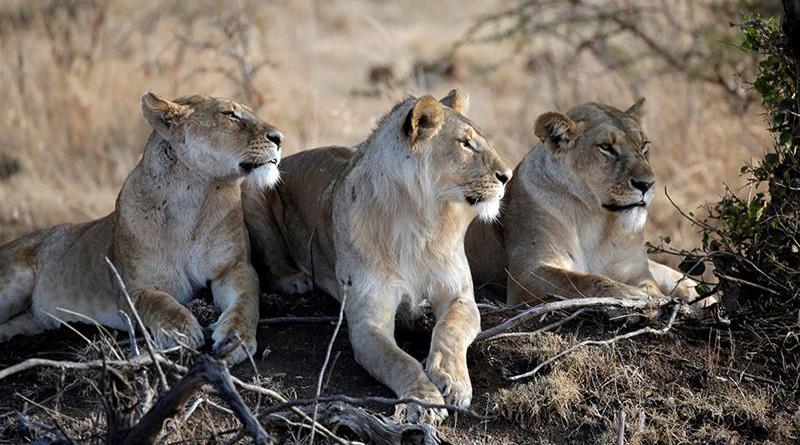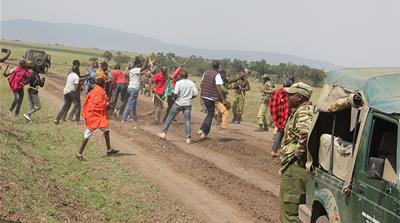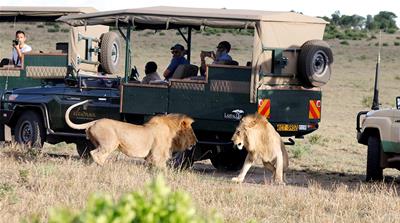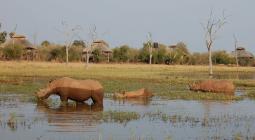Land spat threatens Kenya's wildlife conservation in Maasai Mara.

Kenya's successful conservation model - which has protected wildlife for decades - may be on the verge of crumbling.
Nairobi, Kenya - The giraffes peeked out from above the trees, perhaps curious to see what the hullabaloo was about. Sensing danger, a herd of wildebeests grazing nearby beat a hasty retreat across the fields.
What had been an ordinary Saturday morning in September in the Maasai Mara, one of Kenya's most important conservation areas, had been disrupted by club-wielding Maasai pastoralists driving herds of cattle into a vast expanse of land set aside for wildlife.
Incidents like this one are becoming more common in a land dispute that has unfolded over the past year pitting the Maasai Mara Wildlife Conservancies Association (MMWCA) against a splinter group of livestock farmers.
The disgruntled farmers lease parcels of their land to tourism operators through the MMWCA, which they accuse of cutting landowners out of key decisions and not paying them a fair slice of tourism profits. The farmers now want to renege on contracts with the MMWCA that are not set to expire until 2025.
The outcome of the dispute could have a profound impact on the future of wildlife in and around Kenya's Maasai Mara National Reserve, the lucrative tourist trade it anchors, and even conservation efforts beyond the country.
"Because of this model, Kenya has been recognised internationally for providing some good examples of integrating livestock production and wildlife conservation," MMWCA CEO Daniel Sopia told Al Jazeera. "But if landowners begin pulling their land from the conservancies, it could fracture animal habitats and constrain wildlife mobility."
A virtuous circle
For decades, Kenya's conservation model has successfully demonstrated that wildlife, including endangered species, can survive outside fenced reserve areas if pastoral communities are able to reap a financial benefit from wildlife preservation.
Conservancy agreements with farmers keep land adjacent to wildlife reserves open for migrating animals. Without such arrangements, cattle ranching, crop cultivation and human settlements could all threaten wildlife habitats and grazing lands.
The idea is to create a virtuous circle between landowners, wildlife and tourism. Landowners make money leasing parcels of their property adjacent to reserves to tourism operators via conservancies. The wildlife is protected, drawing in tourists and further benefitting local communities financially.
Over the past decade, the lion population in MMWCA's 15 conservancies has doubled. And tourism, worth an estimated $4m annually, benefits some 3,000 households in the Mara, according to the Kenya Wildlife Conservancies Association.
But long-held suspicions that the system benefits tourism operators more than landowners spilled into the open late last year, following a change in how the conservancies are managed.
For 10 years, a for-profit company, Seiya Limited, had managed two of MMWCA's 15 conservancies - Mara North and Naboisho. But last December, the conservancies switched to a new internally formed, nonprofit entity called Greater Mara Management Limited (GMM).
The new nonprofit GMM manages the conservancies for a 20 percent cut of tourism profits - 10 percent less than the previous for-profit Seiya charged.
GMM has passed the extra 10 percent to leasing landowners - upping the rate farmers receive per leased hectare from 5,510 Kenyan shillings ($53.12) to 8,419 Kenyan shillings ($81.17) per month.
But the extra money has failed to assuage aggrieved landowners who say they had no say in the formation of the new nonprofit entity - a claim disputed by MMWCA.
"Landowners cannot complain that we didn't involve them," said Sopia, "because we had been planning to change the management of the conservancies two year[s] prior to the changes."

Accusations of inequality
The aggrieved landowners believe that tourism operators are still capturing a disproportionately large share of profits.
Kennedy Lepore is among the landowners who wants to terminate his contract with MMWCA early.
"[The foreign tourism company owners'] children live very well, they attend high-end schools, while ours continue to languish in poverty," he told Al Jazeera. "So we're taking our land back from the foreigners to plant maize and wheat, which are more profitable. We'll do electric fences to keep out elephants."
Sixty-one-year old Jeff Koiya, another member of the splinter group who wants out of his lease contract, said he would make more money raising crops or livestock on his land.
"I'll fence off my land and keep livestock on it," Koiya told Al Jazeera. "We will have no interference with tourism activities. We just want our land back."
James Kisharu, a young Maasai cattle farmer, is also frustrated by an arrangement he believes is robbing Maasai youth of their birthright.
"We know and understand the importance of conservancies to the general wildlife welfare in Kenya, but the youth in this area are not benefitting from this conservancy," he told Al Jazeera. "Seventy percent of the (conservancy) employees are from other tribes. The Maasai youth have been left out of the perks that come with this arrangement. We have been sidelined, subjugated and taken advantage of."
Sopia maintains that the for-profit management company, which lost out under the new arrangement, is telling the aggrieved landowners to break leases and grant a proxy company, Koiyaki Mara Land Holding PLC, authority to lease the land to tourism operators.
"The dissenting few are being incited by the former privately contracted management, Seiya, whose contract expired in December," said Sopia.
But Brian Heath, Director of Seiya Limited, refutes such charges. "We weren't causing any problem," he told Al Jazeera. "The landowners came to me [and] I didn't go to incite anybody. But they have this perception that we were the ones aiding them."
Heath says that the successful balance his firm struck between the competing interests of tourism operators and Maasai livestock farmers was bound to tip into conflict eventually.
"We managed for nine years to tread that balance between the two interests," said Heath. "We managed to set up a working rotational grazing scheme. It became apparent over time that the land leases were very punitive and restrictive on the landowner and one-sided in favour of the tourism partner[s], who could do what they liked when they liked and however they liked it."

Regardless of how the conflict began, it shows no signs of abating. That could have dire consequences for a tourist trade that has boosted conservation and the bottom lines of non-landowning members of local communities.
Roughly 150,000 international visitors flock to this part of the world each year to see the spectacular migration of more than a million wildebeests as well as hundreds of thousands of zebras and gazelles between Tanzania and Kenya.
Tourism operators like Greg Monson, the managing director of Kicheche Camps, told Al Jazeera the skirmish is already making tourists wary.
"One of the tourist facilities has reported two cancellations," he said. "The landowners need to understand that if this affects tourism, then there'll be no earning to be made - and hence no income for them."
22 October 2019
ALJAZEERA




